Table of Contents
Bored with the same old meal prep routine? Craving vibrant flavors and a healthy boost? Then it's time to dive headfirst into the world of healthy Asian meal prep ideas! For me, Asian cuisine isn't just food; it's a connection to my heritage, a celebration of diverse cultures, and a delicious way to stay on track with my health goals. From the tangy zest of Thai curries to the umami-rich depths of Japanese bowls and the comforting warmth of Chinese stir-fries, the possibilities are endless. I understand that building an Asian-inspired pantry can feel daunting, but trust me, the payoff is worth it. We'll explore essential ingredients (don't worry, you don't need everything at once!), easy cooking methods, and a breakdown of popular cuisines to get you started. Get ready to transform your meal prep game and infuse your week with exciting, healthy flavors!
Why Healthy Asian Meal Prep is Your Next Obsession
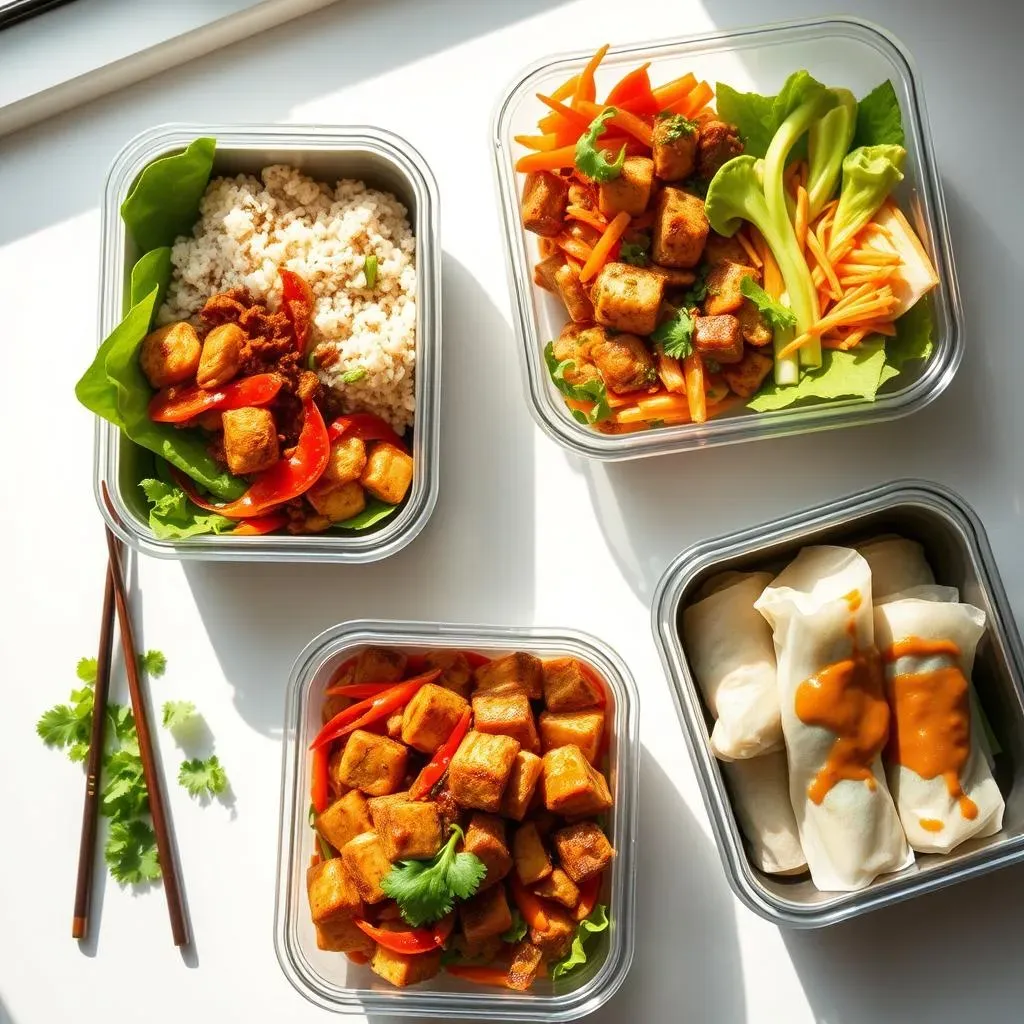
Why Healthy Asian Meal Prep is Your Next Obsession
Flavor Fiesta & Health Boost
Let's be real, meal prep can get boring. Chicken and broccoli every. single. week? No thanks! That's where Asian cuisine swoops in to save the day. We're talking vibrant flavors – think spicy gochujang chicken, fragrant ginger-garlic tofu, and refreshing Vietnamese spring rolls. It's a culinary adventure that keeps your taste buds excited and your body happy. Plus, many Asian dishes are packed with veggies, lean protein, and healthy fats. It's a win-win!
Beyond the deliciousness, Asian meal prep is surprisingly adaptable to various dietary needs. Whether you're vegan, vegetarian, gluten-free, or just trying to eat healthier, there are tons of options. Think tofu stir-fries, veggie-packed noodle bowls, or flavorful lentil curries. The key is to get creative with your ingredients and seasonings. Don't be afraid to experiment and find what works best for you. You might just discover your new favorite healthy meal!
Cultural Connection & Convenience
For many, Asian food is more than just a meal; it's a connection to family, culture, and heritage. Meal prepping these dishes can be a way to honor those roots and share them with others. Think about recreating your grandma's famous kimchi fried rice or your favorite childhood sushi rolls. It's a way to bring comfort and joy into your everyday life.
Let's face it, life is busy. Grabbing takeout is tempting, but it's often expensive and unhealthy. Asian meal prep allows you to enjoy delicious, home-cooked meals without sacrificing convenience. Spend a few hours on the weekend prepping your ingredients and cooking your dishes, and you'll have a week's worth of healthy and flavorful meals ready to go. No more sad desk lunches or last-minute takeout orders!
- Save Time: Prep once, eat all week.
- Save Money: Home-cooked meals are cheaper than takeout.
- Eat Healthier: Control your ingredients and portion sizes.
- Explore New Flavors: Discover the amazing world of Asian cuisine.
Essential Ingredients for Your Healthy Asian Meal Prep Pantry
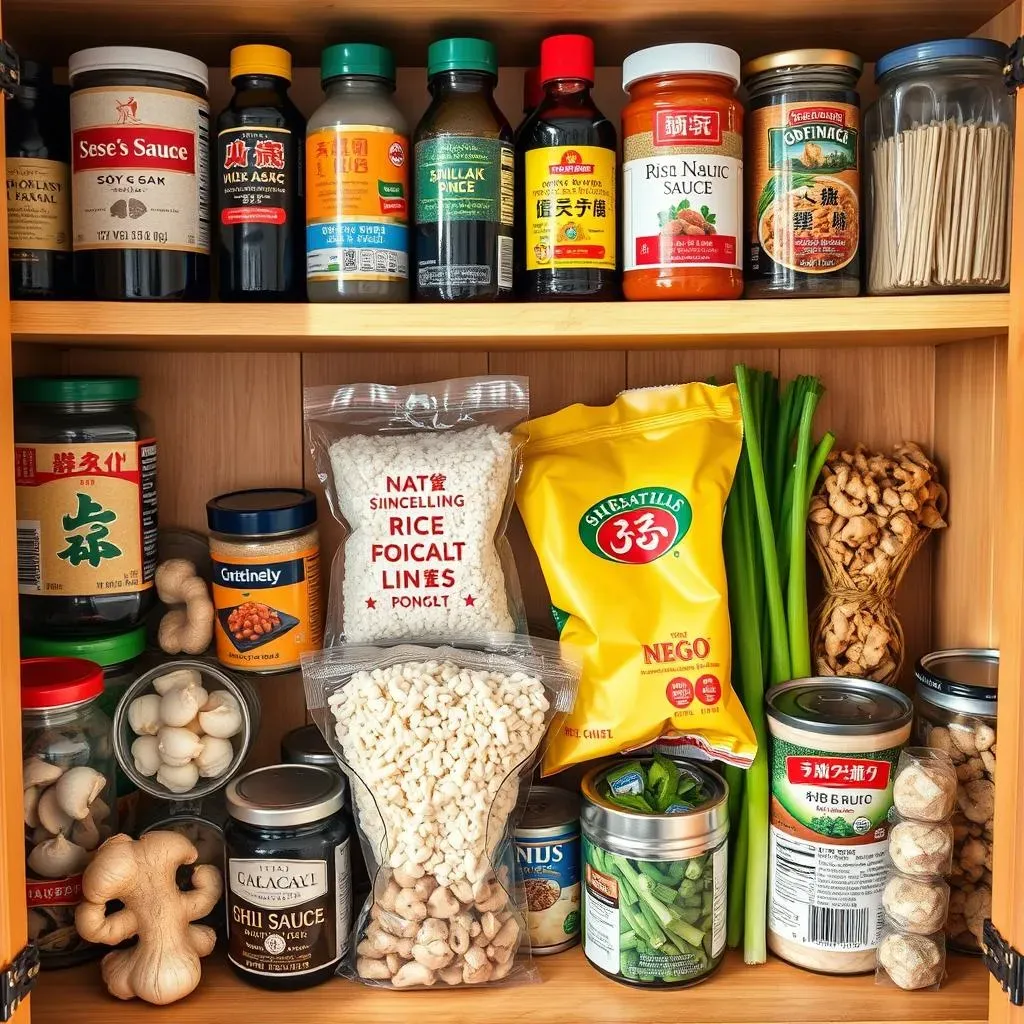
Essential Ingredients for Your Healthy Asian Meal Prep Pantry
The Foundation of Flavor: Must-Have Sauces & Oils
Alright, so you're ready to build your Asian meal prep arsenal? Awesome! Let's start with the flavor powerhouses: sauces and oils. Think of these as the building blocks for almost every dish. Soy sauce is a must-have – it adds that savory, umami depth. Go for low-sodium if you're watching your salt intake. Sesame oil is another essential; a little drizzle adds a nutty aroma and richness. Rice vinegar brings a subtle tang, perfect for dressings and marinades. And don't forget the spicy stuff! Chili garlic sauce or sriracha will kick things up a notch. Fish sauce is a staple in Southeast Asian cuisine, adding a salty, funky depth – don't be scared, it's delicious! Finally, a neutral cooking oil like canola or vegetable oil is important for high-heat cooking.
Once you've got those basics covered, you can start exploring more specialized sauces like oyster sauce (great for stir-fries), hoisin sauce (perfect for marinades), and black bean sauce (adds a deep, savory flavor). The key is to start small and build your collection over time. Don't feel like you need to buy everything at once! Also, don't be afraid to experiment with different brands and varieties to find your favorites. For example, there are tons of different types of soy sauce out there, each with its own unique flavor profile.
Ingredient | Why You Need It | Tips & Tricks |
|---|---|---|
Soy Sauce | Umami, saltiness | Go for low-sodium! |
Sesame Oil | Nutty aroma, richness | A little goes a long way! |
Rice Vinegar | Tangy acidity | Great for dressings! |
Chili Garlic Sauce/Sriracha | Spice, flavor | Add to taste! |
Fish Sauce | Salty, funky depth | Use sparingly at first! |
Beyond the Bottle: Pantry Staples for Asian Cooking
Now that we've covered the sauces and oils, let's move on to the other pantry staples that will elevate your Asian meal prep game. Rice is an obvious one. Jasmine rice is a classic choice for many Asian dishes, but you can also experiment with brown rice, basmati rice, or even sticky rice. Noodles are another must-have. From thin rice noodles to thick udon noodles, there's a noodle for every dish. Dried shiitake mushrooms add an earthy, umami flavor to soups and stir-fries. Cornstarch is essential for thickening sauces and creating crispy coatings. And don't forget the aromatics! Ginger, garlic, and scallions are the holy trinity of Asian cooking. Keep them on hand at all times!
Think about other ingredients like canned bamboo shoots, water chestnuts, and baby corn. These add texture and crunch to stir-fries and other dishes. Also, consider stocking up on dried spices like star anise, cloves, and cinnamon. These add warmth and complexity to your dishes. And finally, don't forget the tofu! Tofu is a versatile ingredient that can be used in a variety of dishes, from stir-fries to soups to salads. Choose firm or extra-firm tofu for the best results when meal prepping.
Mastering the Basics: Cooking Methods for Quick & Healthy Asian Meals
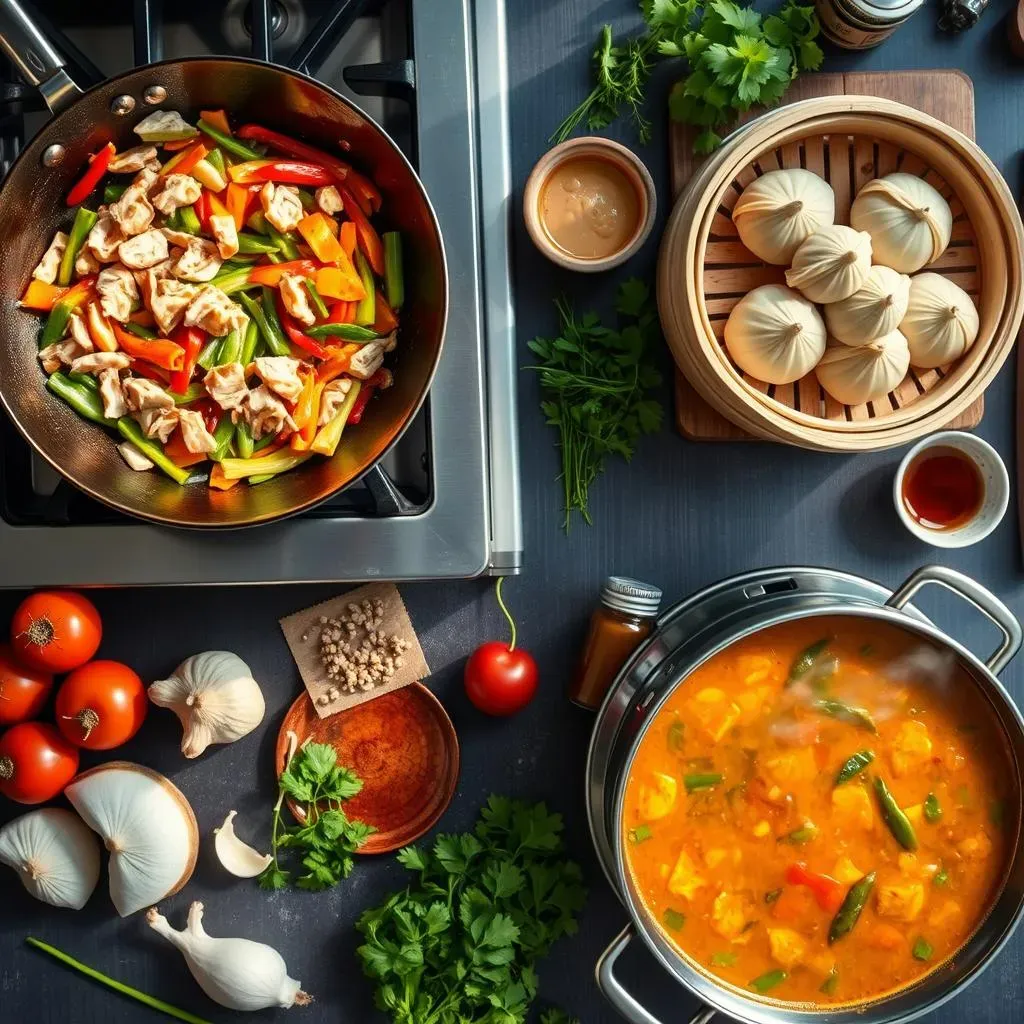
Mastering the Basics: Cooking Methods for Quick & Healthy Asian Meals
Stir-Frying 101: Fast, Fresh, and Flavorful
Stir-frying is your secret weapon for quick and healthy Asian meals. It's all about cooking ingredients over high heat in a wok or large skillet, tossing them constantly to ensure even cooking. The key is to prep everything beforehand – chop your veggies, slice your protein, and have your sauces ready to go. This is because stir-frying happens fast! You don't want to be fumbling around for ingredients while your food is burning. Also, don't overcrowd the pan. If you do, the temperature will drop, and your food will steam instead of stir-fry. Cook in batches if necessary.
When it comes to oil, use a high-smoke-point oil like canola or peanut oil. Sesame oil is great for flavor, but it has a lower smoke point, so add it towards the end of cooking. Start with your aromatics like garlic and ginger, then add your protein, followed by your veggies. Add your sauce at the very end and toss everything together until well coated. Serve immediately over rice or noodles. And remember, practice makes perfect! The more you stir-fry, the better you'll get at it.
Steaming: The Gentle Giant of Healthy Cooking
Steaming is a fantastic way to cook vegetables, dumplings, and even fish while preserving their nutrients and natural flavors. All you need is a steamer basket and a pot with a lid. Fill the pot with water, bring it to a boil, and then place the steamer basket on top. Make sure the water doesn't touch the bottom of the basket! Add your food to the basket, cover the pot, and let it steam until cooked through. It's that easy!
Steaming is particularly great for meal prepping because it's hands-off and doesn't require any added oil. You can steam a big batch of broccoli, carrots, or other veggies and then use them in salads, stir-fries, or noodle bowls throughout the week. You can also steam dumplings or buns for a quick and easy lunch or dinner. For an extra flavor boost, try adding some ginger slices or scallions to the water before steaming. This will infuse the food with a subtle aroma.
Food | Steaming Time (approximate) |
|---|---|
Broccoli Florets | 5-7 minutes |
Carrot Slices | 8-10 minutes |
Dumplings | 10-12 minutes |
Fish Fillets | 8-10 minutes |
One-Pot Wonders: Simplicity at its Finest
Who doesn't love a one-pot meal? They're easy to make, require minimal cleanup, and are perfect for meal prepping. Think about flavorful curries, hearty noodle soups, or comforting rice dishes. The key to a great one-pot meal is to layer your ingredients in the right order. Start with your aromatics, then add your protein, followed by your vegetables and grains. Add your liquid (broth, water, or coconut milk) and bring everything to a simmer. Cover the pot and let it cook until the grains are tender and the flavors have melded together.
One-pot meals are incredibly versatile. You can use whatever ingredients you have on hand and customize them to your liking. Try a Thai green curry with chicken and vegetables, a Japanese udon noodle soup with tofu and mushrooms, or a Chinese congee with rice and pork. The possibilities are endless! And because everything cooks together in one pot, the flavors really meld together, creating a dish that's both delicious and satisfying.
Healthy Asian Meal Prep Ideas: Cuisine Deep Dive
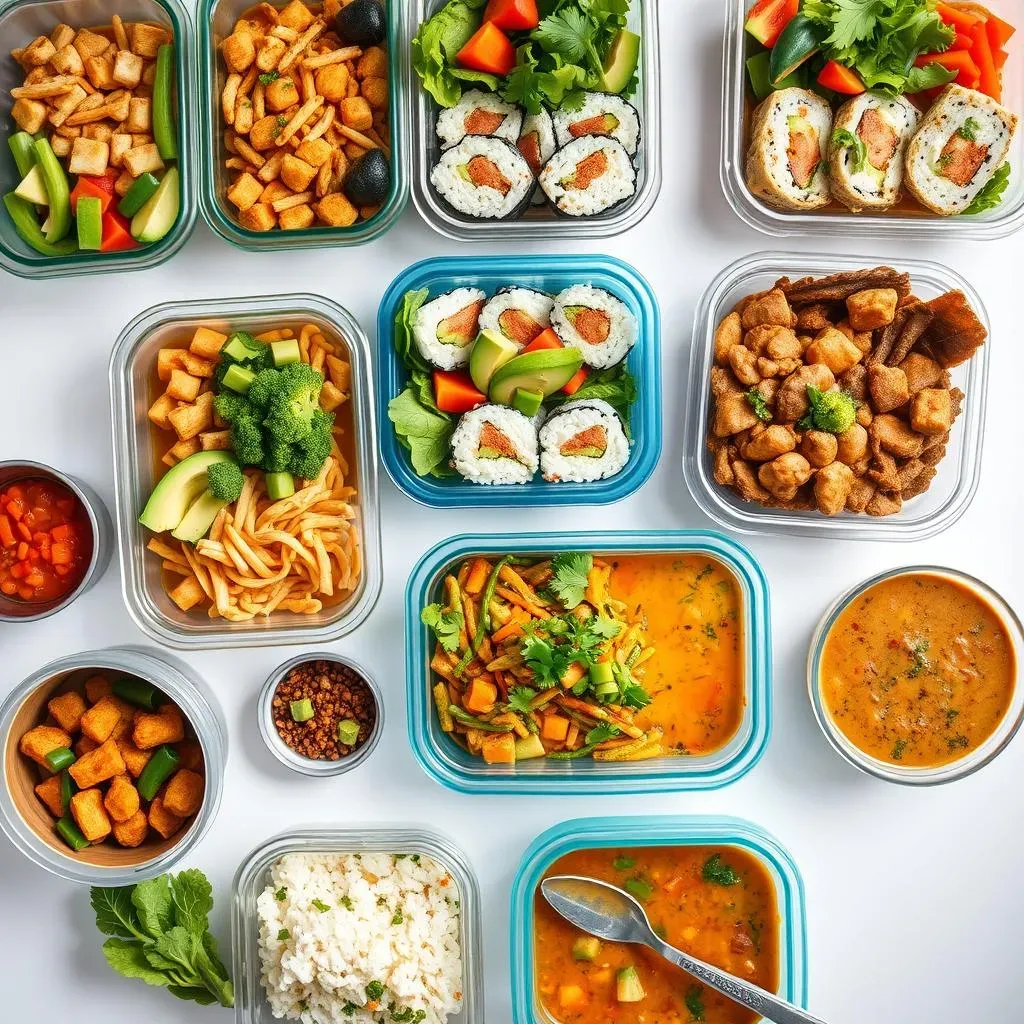
Healthy Asian Meal Prep Ideas: Cuisine Deep Dive
Chinese: Stir-Fries, Dumplings, and Beyond
Let's kick things off with Chinese cuisine, a treasure trove of meal prep potential. Think beyond the greasy takeout! Stir-fries are your best friend here – quick, customizable, and packed with flavor. Load them up with colorful veggies like broccoli, bell peppers, and snap peas, and add lean protein like chicken, tofu, or shrimp. Don't forget the sauce! A simple combination of soy sauce, ginger, garlic, and a touch of honey can work wonders. Dumplings are another great option. Make a big batch on the weekend and steam or pan-fry them for a quick and easy lunch or dinner. Serve them with a dipping sauce made from soy sauce, rice vinegar, and chili oil.
Consider other dishes like Mapo Tofu (silken tofu in a spicy Sichuan sauce), Kung Pao Chicken (chicken stir-fried with peanuts and chili peppers), or Egg Drop Soup (a comforting and light soup). These can all be made ahead of time and reheated easily. When meal prepping Chinese food, focus on dishes that hold up well in the fridge and don't get soggy. Avoid dishes with crispy coatings or fried ingredients, as they will lose their texture over time. Also, be mindful of portion sizes. Chinese food can be high in sodium and calories, so be sure to control your portions and balance your meals with plenty of vegetables.
- Common Ingredients: Soy sauce, ginger, garlic, scallions, rice wine, sesame oil, chili peppers, tofu, bok choy, mushrooms.
- Key Characteristics: Stir-frying, steaming, flavorful sauces, use of aromatics, balance of flavors and textures.
Japanese: Sushi Bowls, Bento Boxes, and Miso Magic
Next up is Japanese cuisine, known for its delicate flavors, fresh ingredients, and beautiful presentation. Sushi bowls are a fantastic way to enjoy the flavors of sushi without the hassle of rolling. Simply layer cooked rice with your favorite sushi toppings like raw fish (if you're comfortable with it), avocado, cucumber, edamame, and seaweed salad. Drizzle with soy sauce or a spicy mayo for extra flavor. Bento boxes are another great option. Fill them with a variety of small dishes like grilled fish, steamed vegetables, pickled ginger, and rice. It's a fun and healthy way to enjoy a balanced meal.
Don't forget about miso soup! It's a comforting and nutritious soup that's easy to make ahead of time. Simply whisk miso paste into hot water or broth and add your favorite toppings like tofu, seaweed, and scallions. You can also try making Japanese curry, a mild and flavorful curry that's perfect for meal prepping. Serve it with rice and your favorite vegetables. When meal prepping Japanese food, focus on dishes that are light, fresh, and not too heavy on the sauces. Avoid dishes with fried ingredients or creamy sauces, as they will not hold up well in the fridge.
Dish | Meal Prep Tip |
|---|---|
Sushi Bowls | Use cooked fish or tofu if you're not comfortable with raw fish. |
Bento Boxes | Pack a variety of small dishes for a balanced meal. |
Miso Soup | Make a big batch and store it in the fridge for easy lunches. |
Japanese Curry | Add your favorite vegetables for a nutritious and flavorful meal. |
Thai: Curries, Noodles, and Tropical Flavors
Thai cuisine is a symphony of sweet, sour, salty, and spicy flavors. Curries are a meal prep staple – they're easy to make, packed with flavor, and can be customized to your liking. Choose your favorite curry paste (green, red, or yellow), add coconut milk, vegetables, and protein, and simmer until everything is cooked through. Serve with rice or noodles. Pad Thai is another classic Thai dish that's perfect for meal prepping. Stir-fry rice noodles with shrimp, tofu, peanuts, and a tangy tamarind sauce.
Consider other dishes like Tom Yum soup (a hot and sour soup with lemongrass, galangal, and chili peppers), Mango Sticky Rice (a sweet and creamy dessert), or Thai Basil Chicken (chicken stir-fried with basil and chili peppers). These can all be made ahead of time and reheated easily. When meal prepping Thai food, be mindful of the spice level. Thai food can be very spicy, so adjust the amount of chili peppers to your liking. Also, be sure to use fresh ingredients whenever possible. The flavors of Thai food are best when made with fresh herbs and vegetables.
Filipino: Adobo, Sinigang, and Comfort Food Classics
Filipino cuisine is a melting pot of flavors, influenced by Spanish, Chinese, and American cultures. Adobo is the national dish of the Philippines – a savory and tangy stew made with meat (usually chicken or pork), soy sauce, vinegar, garlic, and black peppercorns. It's easy to make ahead of time and reheats beautifully. Sinigang is another popular Filipino dish – a sour and savory soup made with tamarind broth, vegetables, and meat or seafood. It's a comforting and flavorful soup that's perfect for a cold day.
Consider other dishes like Lumpia (Filipino spring rolls), Pancit (Filipino noodles), or Lechon (roasted pig). These can all be made ahead of time and reheated easily. When meal prepping Filipino food, be mindful of the salt content. Filipino food can be high in sodium, so be sure to use low-sodium soy sauce and other ingredients. Also, be sure to balance your meals with plenty of vegetables and rice.
Indian: Curries, Lentils, and Aromatic Spices
Last but not least, we have Indian cuisine, a world of aromatic spices, flavorful curries, and hearty lentil dishes. Curries are a meal prep staple – they're easy to make, packed with flavor, and can be customized to your liking. Choose your favorite curry powder or paste, add coconut milk or tomato sauce, vegetables, and protein, and simmer until everything is cooked through. Serve with rice or naan bread. Lentil soup (dal) is another great option. It's a hearty and nutritious soup that's perfect for a cold day.
Consider other dishes like Biryani (a mixed rice dish with meat, vegetables, and spices), Samosas (fried or baked pastries filled with potatoes and peas), or Butter Chicken (chicken in a creamy tomato sauce). These can all be made ahead of time and reheated easily. When meal prepping Indian food, be mindful of the spice level. Indian food can be very spicy, so adjust the amount of chili peppers to your liking. Also, be sure to use fresh spices whenever possible. The flavors of Indian food are best when made with fresh, high-quality spices.
Making it Work: Tips for Streamlining Your Healthy Asian Meal Prep Routine
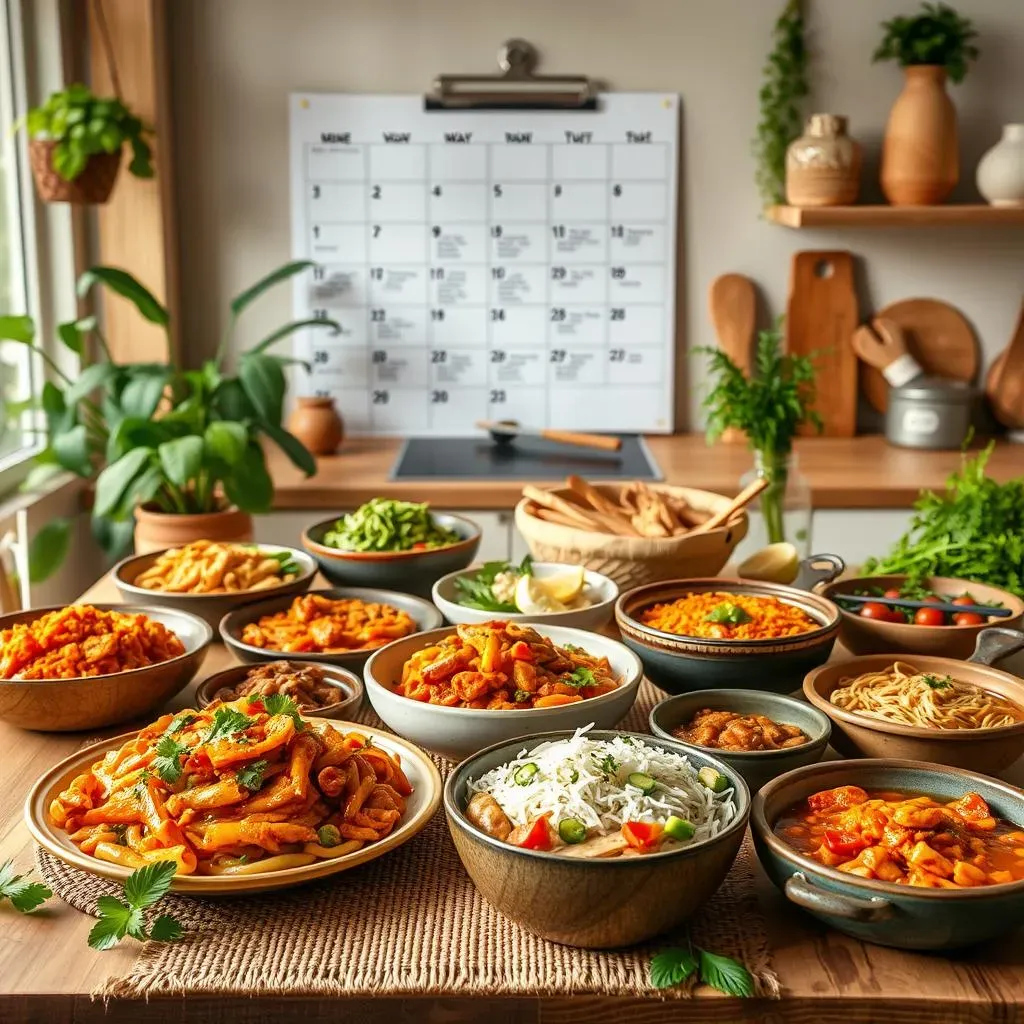
Making it Work: Tips for Streamlining Your Healthy Asian Meal Prep Routine
Plan Ahead: Your Meal Prep Roadmap
Alright, so you're pumped to dive into healthy Asian meal prep, but where do you even start? The secret sauce is planning! Take some time each week to map out your meals. Consider what you're craving, what ingredients you already have on hand, and what's on sale at the grocery store. Create a detailed meal plan that includes breakfast, lunch, dinner, and snacks. This will not only save you time and money but also ensure that you're eating a balanced and nutritious diet. Trust me, a little planning goes a long way!
Once you have your meal plan, create a shopping list and stick to it. This will prevent you from buying unnecessary ingredients and impulse purchases. Before you head to the store, check your pantry and fridge to see what you already have. This will help you avoid buying duplicates and save you even more money. And don't forget to factor in leftovers! If you're making a big batch of curry for dinner, plan to use the leftovers for lunch the next day. This will save you time and effort in the long run.
Prep Like a Pro: Batch Cooking & Smart Storage
Now that you have your meal plan and your ingredients, it's time to get cooking! The key to efficient meal prep is batch cooking. Choose a day (usually Sunday) to dedicate a few hours to cooking all of your meals for the week. This may seem daunting, but it's actually a lot easier than it sounds. Start by prepping all of your ingredients – chop your veggies, marinate your protein, and cook your grains. Then, start cooking your dishes in large batches. This will save you time and effort in the long run.
Once your meals are cooked, it's important to store them properly to ensure that they stay fresh and delicious all week long. Invest in some high-quality, airtight containers. These will keep your food from drying out and prevent it from absorbing odors from the fridge. Label each container with the name of the dish and the date it was made. This will help you keep track of what you have and when it needs to be eaten. And don't forget to store your meals in the fridge as soon as they've cooled down. This will prevent bacteria from growing and keep your food safe to eat.
Tip | Explanation |
|---|---|
Invest in good containers | Airtight containers keep food fresh. |
Label everything | Know what's inside and when you made it. |
Cool food quickly | Prevent bacteria growth. |
Use clear containers | See what you have at a glance. |
Embrace Shortcuts: Pre-Cut Veggies & Smart Swaps
Let's be honest, sometimes you just don't have time to chop a mountain of vegetables. That's where shortcuts come in! Don't be afraid to buy pre-cut veggies. They may be a little more expensive, but they'll save you a ton of time. You can also use pre-cooked grains like quinoa or brown rice. These are great for adding healthy carbs to your meals without having to spend hours in the kitchen. Also, consider using store-bought sauces and marinades. There are tons of great options available that are low in sodium and sugar. Just be sure to read the labels carefully.
Another great shortcut is to make smart swaps. For example, instead of making your own dumplings from scratch, buy frozen dumplings. They're just as delicious and take a fraction of the time to cook. Or, instead of making your own sushi rice, use pre-cooked sushi rice. These small changes can make a big difference in your meal prep time. The goal is to make healthy eating as easy and convenient as possible. So don't be afraid to embrace shortcuts and smart swaps to streamline your meal prep routine.
Your Healthy Asian Meal Prep Adventure Awaits
So, are you ready to ditch the boring and embrace the bold? Exploring healthy Asian meal prep ideas is a fantastic way to add variety, flavor, and cultural richness to your diet. Don't be afraid to experiment with different cuisines, ingredients, and cooking methods. Start small, maybe with one or two recipes a week, and gradually expand your repertoire. The most important thing is to have fun and enjoy the process of creating delicious and healthy meals that nourish your body and soul. And hey, if you're looking for a complete meal plan to kickstart your journey, stay tuned – I've got something special in the works! Now go forth and prep like a pro!